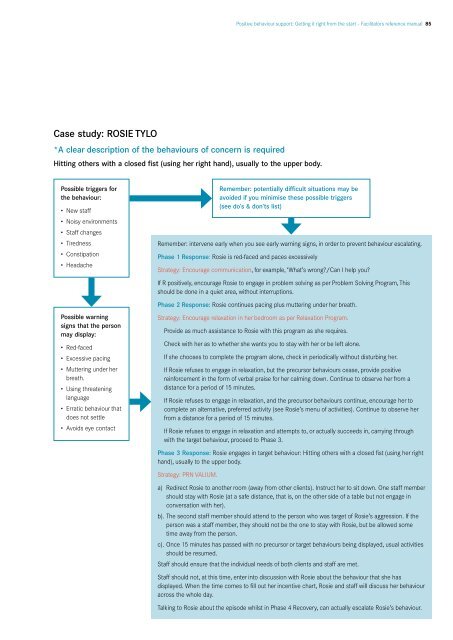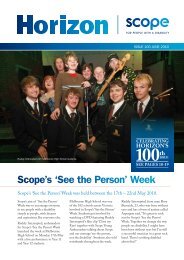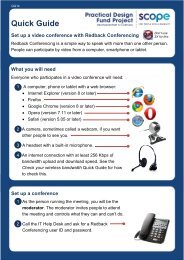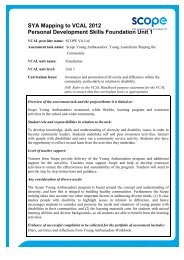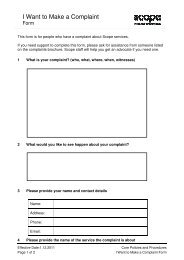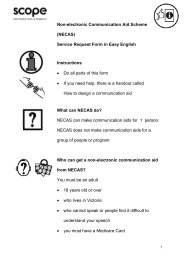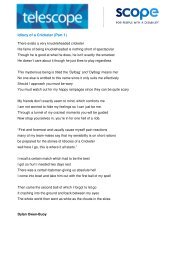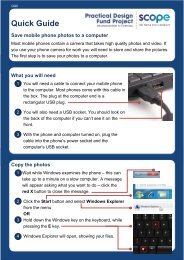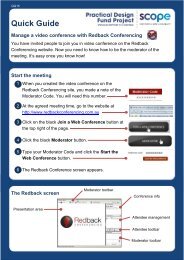Positive behaviour support Getting it right from the start
Positive behaviour support Getting it right from the start
Positive behaviour support Getting it right from the start
You also want an ePaper? Increase the reach of your titles
YUMPU automatically turns print PDFs into web optimized ePapers that Google loves.
<strong>Pos<strong>it</strong>ive</strong> <strong>behaviour</strong> <strong>support</strong>: <strong>Getting</strong> <strong>it</strong> <strong>right</strong> <strong>from</strong> <strong>the</strong> <strong>start</strong> - Facil<strong>it</strong>ators reference manual 85<br />
Case study: ROSIE TYLO<br />
*A clear description of <strong>the</strong> <strong>behaviour</strong>s of concern is required<br />
H<strong>it</strong>ting o<strong>the</strong>rs w<strong>it</strong>h a closed fist (using her <strong>right</strong> hand), usually to <strong>the</strong> upper body.<br />
Possible triggers for<br />
<strong>the</strong> <strong>behaviour</strong>:<br />
• New staff<br />
• Noisy environments<br />
• Staff changes<br />
• Tiredness<br />
• Constipation<br />
• Headache<br />
Remember: potentially difficult s<strong>it</strong>uations may be<br />
avoided if you minimise <strong>the</strong>se possible triggers<br />
(see do’s & don’ts list)<br />
Remember: intervene early when you see early warning signs, in order to prevent <strong>behaviour</strong> escalating.<br />
Phase 1 Response: Rosie is red-faced and paces excessively<br />
Strategy: Encourage communication, for example, ‘What’s wrong?/Can I help you?<br />
If R pos<strong>it</strong>ively, encourage Rosie to engage in problem solving as per Problem Solving Program, This<br />
should be done in a quiet area, w<strong>it</strong>hout interruptions.<br />
Phase 2 Response: Rosie continues pacing plus muttering under her breath.<br />
Possible warning<br />
signs that <strong>the</strong> person<br />
may display:<br />
• Red-faced<br />
• Excessive pacing<br />
• Muttering under her<br />
breath.<br />
• Using threatening<br />
language<br />
• Erratic <strong>behaviour</strong> that<br />
does not settle<br />
• Avoids eye contact<br />
Strategy: Encourage relaxation in her bedroom as per Relaxation Program.<br />
Provide as much assistance to Rosie w<strong>it</strong>h this program as she requires.<br />
Check w<strong>it</strong>h her as to whe<strong>the</strong>r she wants you to stay w<strong>it</strong>h her or be left alone.<br />
If she chooses to complete <strong>the</strong> program alone, check in periodically w<strong>it</strong>hout disturbing her.<br />
If Rosie refuses to engage in relaxation, but <strong>the</strong> precursor <strong>behaviour</strong>s cease, provide pos<strong>it</strong>ive<br />
reinforcement in <strong>the</strong> form of verbal praise for her calming down. Continue to observe her <strong>from</strong> a<br />
distance for a period of 15 minutes.<br />
If Rosie refuses to engage in relaxation, and <strong>the</strong> precursor <strong>behaviour</strong>s continue, encourage her to<br />
complete an alternative, preferred activ<strong>it</strong>y (see Rosie’s menu of activ<strong>it</strong>ies). Continue to observe her<br />
<strong>from</strong> a distance for a period of 15 minutes.<br />
If Rosie refuses to engage in relaxation and attempts to, or actually succeeds in, carrying through<br />
w<strong>it</strong>h <strong>the</strong> target <strong>behaviour</strong>, proceed to Phase 3.<br />
Phase 3 Response: Rosie engages in target <strong>behaviour</strong>: H<strong>it</strong>ting o<strong>the</strong>rs w<strong>it</strong>h a closed fist (using her <strong>right</strong><br />
hand), usually to <strong>the</strong> upper body.<br />
Strategy: PRN VALIUM.<br />
a) Redirect Rosie to ano<strong>the</strong>r room (away <strong>from</strong> o<strong>the</strong>r clients). Instruct her to s<strong>it</strong> down. One staff member<br />
should stay w<strong>it</strong>h Rosie (at a safe distance, that is, on <strong>the</strong> o<strong>the</strong>r side of a table but not engage in<br />
conversation w<strong>it</strong>h her).<br />
b). The second staff member should attend to <strong>the</strong> person who was target of Rosie’s aggression. If <strong>the</strong><br />
person was a staff member, <strong>the</strong>y should not be <strong>the</strong> one to stay w<strong>it</strong>h Rosie, but be allowed some<br />
time away <strong>from</strong> <strong>the</strong> person.<br />
c). Once 15 minutes has passed w<strong>it</strong>h no precursor or target <strong>behaviour</strong>s being displayed, usual activ<strong>it</strong>ies<br />
should be resumed.<br />
Staff should ensure that <strong>the</strong> individual needs of both clients and staff are met.<br />
Staff should not, at this time, enter into discussion w<strong>it</strong>h Rosie about <strong>the</strong> <strong>behaviour</strong> that she has<br />
displayed. When <strong>the</strong> time comes to fill out her incentive chart, Rosie and staff will discuss her <strong>behaviour</strong><br />
across <strong>the</strong> whole day.<br />
Talking to Rosie about <strong>the</strong> episode whilst in Phase 4 Recovery, can actually escalate Rosie’s <strong>behaviour</strong>.


